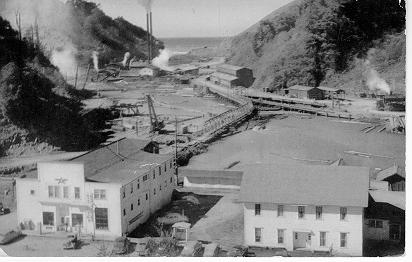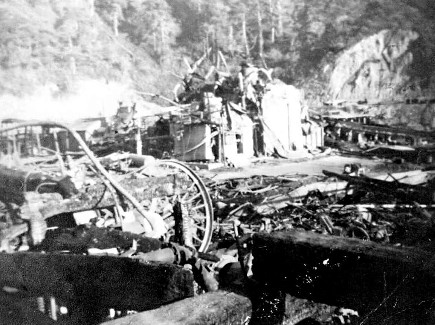| 
Hollywood learned long ago that Americans
love a comeback story. While it probably will
never find its way onto the big screen like Seabiscuit,
the tale of Rockport Redwood Company has its
own human drama of loss and return. At the center
of the story is a wealthy family and a small
company town on a rugged, isolated coastline.
Ambitions and struggles are set against the
backdrop of three major developments of 20th
century history—The Great Depression (1929-1940),
World War II (1939-1945), and Post War American
Culture (1945-1960).
As often happens,
failed businesses are opportunities for other
entrepreneurs. "Opportunity is missed by most,"
Thomas Edison said, "because it is dressed in
overalls and looks like work."  After two company
failures in a row and a mill that had been idle
for four years, the property creditors, with E. T. Dusenbury
as trustee, finally foreclosed on the Finkbine-Guild
mortgage and on January 14, 1933 transferred
title of the property to the newly chartered
Cottaneva Redwood Company (Rockport Records,
ctn 19, folder 59). Another four years passed.
So did E. T. Dusenbury, who died on January
30, 1937 of asthma (MB, Vol. LIX, no. 19, 6
February 1937, p.1).
The mill continued to sit empty and rusting
and its owners were anxious to strike a deal.
Along came Ralph M. Rounds—a midwestern
lumberman. After two company
failures in a row and a mill that had been idle
for four years, the property creditors, with E. T. Dusenbury
as trustee, finally foreclosed on the Finkbine-Guild
mortgage and on January 14, 1933 transferred
title of the property to the newly chartered
Cottaneva Redwood Company (Rockport Records,
ctn 19, folder 59). Another four years passed.
So did E. T. Dusenbury, who died on January
30, 1937 of asthma (MB, Vol. LIX, no. 19, 6
February 1937, p.1).
The mill continued to sit empty and rusting
and its owners were anxious to strike a deal.
Along came Ralph M. Rounds—a midwestern
lumberman.
Born in Alliance,
Nebraska on January 22, 1891, Rounds was the only son of
Dwight C. Rounds. His father, president of Rounds and
Porter Lumber Company, operated retail lumber yards in
Kansas, Oklahoma, and Texas. Rounds graduated from
Stanford University in 1913 with a degree in history
from the School of Humanities and Sciences. At the age
of 30 he married Rebecca Cooper in Wichita, Kansas and
raised two sons there. Ralph Cooper, who would go by the
name of Bill, was born on August 17, 1923; Dwight Merle,
on May 15, 1926.
The Rounds
patriarch died at his home in Hollywood, California
in 1938. That was the year that his son Ralph
would expand operations to California redwood
country. The 46-year-old entrepreneur unexpectedly
saw a sweet deal beckoning in Rockport, California.
Frank Kilpatrick, vice-president of Rockport
Redwood Company, recalled in 1963 an early conversation
with Rounds:
|
Mr. Rounds
once told me how he came to purchase
Rockport and he said that he had not
really been looking for that sort of
an investment when he came across it
but he made such a good deal he could
not turn it down. The owners offered
to sell Ralph Rockport for $400,000.
He was to pay for the stock and the
money went into the corporation and
this would furnish the money with which
to operate—little did he know then how
much it was going to take to get the
thing going. (Rockport Records, ctn
19, folder 59) |
Prior to the Rockport sale, Rounds was given
a walk through a part of the forest. At the
time, walking was the only way to get in and
out. Kilpatrick suggests in his 1963 recollection
that the spot selected, Middle Creek, was not
typical of the property as a whole and that
later inspections would fall short of Rounds'
expectations. If this was the case, it was not
unusual in property sales then or now. In any
event, Kilpatrick's memory proved accurate;
a letter sent from Rounds in Wichita to Kilpatrick
at the San Francisco office, dated 6 June 1950,
states his disappointment:
|
You ask
me how much timber I thought we had
when we first purchased Rockport. At
that time, I thought we had approximately
one billion feet of standing timber
there . . . I know that Mr. Dusenbury
was very disappointed, when I saw him
a few years after we had taken over
the operation, to learn from me that
we were not going to get the billion
feet we had hoped to get. I cannot tell
you what Mr. Ed Dusenbury thought about
the timber when he bid in the property
in 1932 or 1933, but I do know he considered
the Hollow Tree tract an unusually heavy
stand of good quality timber and, if
he were still alive, I know he would
feel as disappointed about it as we
do. (Rockport Records, ctn 19, folder
59) |
Since foresight
is not as common as hindsight, Rounds and his
associates took the lease in 1937 on the Cottoneva
Redwood Company with an option to buy. In a
proposal letter dated and accepted on 17 December
1937, Rounds agreed to pay Cottoneva Redwood
Company $1 per thousand feet of lumber sawed
at the mill to lease the mill, the logging railroad
and equipment, and the houses (Rockport Records,
ctn 19, folder 59-30). In cutting and removing
timber, Rounds would pay $2 per thousand feet
of logs, measured at the log deck (ibid). Rounds
also agreed to pay the current real estate and
personal taxes of $7,238.31, to pay the installment
on the delinquent taxes, and to pay the current
insurance premium of $5,562.12 (ibid). Logging
and milling began the following year in Rockport
around the first of April (MB, Vol. LX, no.
16, 15 January 1938, p.1). Exercising his option
in 1941, Rounds and his associates purchased
the Cottoneva Redwood Company and changed its
name to the Rockport Redwood Company. Operations
at that time included a sawmill, a company town,
and approximately 30,000 acres of timberland.
Initially, Rockport
Redwood Company used the logging and milling
equipment from the Finkbine-Guild operation,
including four Shay locomotives and a Lawson
Flyer. A letter dated 1 January 1926 from J.
D. Alexander, the manager for Finkbine-Guild,
indicates that Shay Locomotive No. 1 had originally
been shipped to Rockport at a cost of $1,872.94
(Rockport Records, ctn 19, folder 58-23). Ralph
Rounds even resurrected one of the old towers
built by Finkbine-Guild. When Finkbine-Guild
was operating, there was a large tower on the
mainland and a smaller tower on an offshore
rock. Between the towers was a cable system
powered by a Lidgerwood engine that transported
the lumber from the mainland to the rock. When
Rounds acquired the Rockport property, the large
tower remained, although in disrepair, but the
smaller one was gone (Rockport Records, ctn
19, folder 59). Rounds, at considerable expense,
overhauled the tower and cable system and loaded
one shipment of lumber on a schooner. All this
effort was actually a ploy to exact "reasonable"
hauling rates from the truckers who were reluctant
to make the trip to Rockport. Rounds proved
to the truckers that, if push came to shove,
he could get his lumber to market the old-fashioned
way—by sea. The truckers negotiated. By
1940 all wood operations in the Rockport forest
were carried out by tractor and truck. Moreover,
all lumber produced at Rockport was sold to
the Rounds Lumber Company and sent to the 45-acre
Rounds plant 3 miles south of Cloverdale on
Highway 101. Rockport Redwood Company itself
had no sales organization. The Rounds Lumber
Company sold the Rockport lumber to retail lumber
dealers in northern California and to lumber
wholesalers in other parts of the country (Rockport
Records, ctn 19, folder 59-30).

Sawmills have always been
susceptible to fires and there were a succession of
fires at the various Rockport mills over the years. In
1942, the mill at Rockport Redwood Company was added to
that list. The mill fire occurred shortly after 5:30
a.m. on Tuesday, September 8. Fortunately, all the
lumber on hand, approximately 5-6 million board feet,
were saved (MB, Vol. LXIII, no. 50, 12 September 1942,
p.1). The company leased a small mill at Juan Creek
while the Rockport mill was rebuilt (MB, Vol. LXV, no.
5, 31 October 1942). Rounds faced other obstacles
besides the fire itself. With World War II in full
swing, many items were rationed or impossible to get. In
a speech on April 28, 1942, President Franklin Roosevelt
(1882-1945) rallied Americans to sacrifice for the war
effort:
As we here at
home contemplate our own duties, our own
responsibilities, let us think and think hard of
the example which is being set for us by our
fighting men. Our soldiers and sailors are
members of well-disciplined units. But they're
still and forever individuals, free individuals.
They are farmers and workers, businessmen,
professional men, artists, clerks. They are the
United States of America. That is why they
fight. We too are the United States of America.
That is why we must work and sacrifice. It is
for them. It is for us. It is for
victory.
Franklin D.
Roosevelet
|
| |
 |
|
The U.S. military
had first claim on aluminum, steel, rubber,
machine parts, and gasoline, as well as items
like coffee, sugar, and cigarettes. In salvaging
drives, small-town America gathered together
rubber tires and rubber duckies, tin cans, bottles,
and even women's silk and nylon hosiery for
parachutes. This was America's first taste of
re-cycling. While ordinary Americans felt the
pinch, so did American businesses. Rockport mill was just one of many during the war
years that had to be rebuilt with used parts.War
meant not just a scarcity of parts but a scarcity
of labor as well. Kilpatrick spoke of this years
later:
|
We had
great difficulties during the war keeping
men. We had two men in Sacramento -
man catchers with [a} pick up truck
bringing men back and forth. The men
usually brought a jug of wine and worked
2 or 3 days and we would have to send
them back. Jack Mitchell was a man catcher.
He would load up in Los Angeles in a
7 passenger car and drive across country.
We were able to get gasoline to import
the workers from Los Angeles. We recruited
them from Sacramento, quite a few from
Los Angeles and Atoka, Oklahoma and
the Atoka people turned out quite well
- better than Los Angeles. The Oklahoma
people were good people. (Rockport Records,
ctn 19, folder 59) |
Rounds also experienced
the war in more personal and profound ways than
just scrounging for mill parts or hiring workers.
While the 53-year old Rounds looked after business,
his 20-year old son, Bill, went to
war on a B-24 bomber crew.
A different strife came
on the heels of the war. Rockport mill, like
others in northern California, was halted by
a worker strike. The
strike lasted a total of 818 days, from January
14, 1946 to April 11, 1948. Kilpatrick recounted
in 1963 the effect of the strike on Rockport
Redwood Company:
In 1947 we had the strike that lasted
27 months. We were down about six
months and finally decided, along
with the other mill owners, to start
up so we had a little mill down there
and so we filed the saws with very
heavy gauge to make a lot of noise
and started up the mill. So the pickets
out there could hear the mill running
and did not know whether we were cutting
lumber or what but we were cutting
up slabs. So the first day we operate
with 12 or 15 men coming in and the
second day only 6 or 7 came in and
we thought we were blown up and I
remember these figures because it
was such a critical time and the next
day about 20 men came in. From there
we were off to the races with our
men going through the picket lines
and a lot of our people tore up the
union cards and threw them in the
faces of the pickets. We never had
a union since. About that time some
of the other mills started to break
the strike and all started the same
time. We took a wagonload of provisions
around to the people and we had some
terrible battles among the people
there - those in favor of the strike
and those who were not. Much hard
feeling at the time. We had a bad
time collecting the rent from strikers
but we finally did get some [and]
forgave a lot, too. A lot went through
the picket line who had belonged to
the union before. We have had four
or five elections at Rockport. (Rockport
Records, ctn 19, folder 59)
|
There is some evidence
that Ralph Rounds, having faced a number of
disappointments and challenges with the Rockport
property right from the start, was considering
putting the 30,000 acres up for sale. In a note
to Kilpatrick scribbled on a prospectus prepared
by Cottoneva Redwood Company and given to Ralph
Rounds in December 1937 as he pondered the lease-to-buy
deal that was being offered to him, Rounds wrote:
K.
This prospectus
helped sell Rockport to me. Maybe
we can get up one to sell to a willing
buyer.
R. 12/6/48
(Rockport
Records, ctn 19, folder 59-30)
|
While managing to
limp along into the 1950s, even purchasing a
Helio Courier at
one point, Rockport Redwood Company finally
fell to competition and inefficient technology.
Toward the end, they were, as companies before
them, simply liquidating the timber stock (Agrons
interview). In 1955, Kilpatrick described the
land as "approximately 12,000 acres in virgin
timberland, approximately 16,000 acres cut over
land, and approximately 2,000 acres of grassland"
and added that "some of the cut over land was
logged 20-30-40 years ago and the rest logged
by this company" (Rockport Records, ctn 19,
folder 59-30, letter of F.C. Kilpatrick, 12
April 1955). While the company was still engaging
in clear cutting, Kilpatrick notes that most
of the current logging was "on a selective basis,
leaving the smaller trees" (ibid). Ralph Rounds,
in a letter to Kilpatrick on 17 September 1957,
finally confirmed the decision to call it quits:
I think the
longer we put off the closing of our Rockport
sawmill, the greater will be our financial loss;
and so I think we reached a good decision this
afternoon, when we decided to "blow the whistle"
on October 1st. (Rockport Records, ctn 17,
folder
54-14)
|
With the mill closed,
the owners began re-seeding the cut-over forest
and proceeded to take a closer inventory of
their biggest asset, namely the land and the
remaining virgin timber. They also took stock
of the logs that remained at the mill. L. I.
Holmes, the Vice-President and General Manager
at Rockport at the time of the mill closure,
wrote to F. C. Kilpatrick on February 10, 1958:
We have
approximately
4,000,000 FBM
redwood logs
2,500,00 FBM fir
logs
on hand at
Rockport. It can be estimated that 70 percent of
this volume, both in redwood and fir, is in logs
30 inches and less in diameter. This means that
we have 4,000,000 FBM useable in our Gang Mill.
(Rockport Records, ctn 17, folder
54-14) |
Events would take
another turn after Ralph M. Rounds' death on
July 23, 1960 in Taos, New Mexico at the age
of 69 (Wichita Eagle, 24 July 1960, p. 5A).
That same year, the Rockport Redwood Company certified its timberlands
as the Ralph M. Rounds Tree Farm, selling timber
to neighboring companies. The term "tree farm"
originated two decades earlier in the 1940s,
as the timber industry introduced the concept
of sustainable forestry and continual stewardship.
Farming implies continuous nurturing and commitment
to a "crop" year after year. Tree farming was
the polar opposite of the "cut-out and get-out"
strategy of some timber industrialists. On August
25, 1965, Rockport Redwood Company, with Carl
Nelson now as president, dedicated their Demonstration
Forest, only the third such forest in a chain
to be developed in the redwood region and the
first in Mendocino County (Rockport Records,
ctn 3, folder 3-18). It was to be an outdoor
classroom for the public to learn about the
ecology of a second-growth redwood forest. Today
it is on the northern edge of MRC land and serves
as a picnic area and walking trail. A bronze
plaque to Ralph M. Round, however, is still
in place.
Rockport Redwood Company certified its timberlands
as the Ralph M. Rounds Tree Farm, selling timber
to neighboring companies. The term "tree farm"
originated two decades earlier in the 1940s,
as the timber industry introduced the concept
of sustainable forestry and continual stewardship.
Farming implies continuous nurturing and commitment
to a "crop" year after year. Tree farming was
the polar opposite of the "cut-out and get-out"
strategy of some timber industrialists. On August
25, 1965, Rockport Redwood Company, with Carl
Nelson now as president, dedicated their Demonstration
Forest, only the third such forest in a chain
to be developed in the redwood region and the
first in Mendocino County (Rockport Records,
ctn 3, folder 3-18). It was to be an outdoor
classroom for the public to learn about the
ecology of a second-growth redwood forest. Today
it is on the northern edge of MRC land and serves
as a picnic area and walking trail. A bronze
plaque to Ralph M. Round, however, is still
in place.
 In
the final years of Rockport Redwood Company,
Bernard Z. Agrons was given the task of managing
the inventory crews and proposing a management
plan for the Rockport timberlands. The plan
called for a moratorium on harvesting with only
a light selective cut in 15 years and culling
of defective trees and some mature second growth
trees to allow growing space for new vigorous
trees. This plan was never carried out. The
heir to the Rockport property was one of Ralph
Rounds' sons, Bill. Bill finally sold the Ralph
M. Rounds Tree Farm and the town of Rockport
to Georgia-Pacific on July 30, 1968. In 1973
the Rounds Tree Farm, the Georgia-Pacific timberlands
throughout northern California, and the former
town of Rockport was spun off into Louisiana-Pacific.
MRC purchased the Louisiana-Pacific lands, including
the Rockport town site, in 1998. In
the final years of Rockport Redwood Company,
Bernard Z. Agrons was given the task of managing
the inventory crews and proposing a management
plan for the Rockport timberlands. The plan
called for a moratorium on harvesting with only
a light selective cut in 15 years and culling
of defective trees and some mature second growth
trees to allow growing space for new vigorous
trees. This plan was never carried out. The
heir to the Rockport property was one of Ralph
Rounds' sons, Bill. Bill finally sold the Ralph
M. Rounds Tree Farm and the town of Rockport
to Georgia-Pacific on July 30, 1968. In 1973
the Rounds Tree Farm, the Georgia-Pacific timberlands
throughout northern California, and the former
town of Rockport was spun off into Louisiana-Pacific.
MRC purchased the Louisiana-Pacific lands, including
the Rockport town site, in 1998.
Rockport Redwood Company
presided over the end of an era on this northernmost
slice of Mendocino coast. Under its watch, the last mill
since milling operations first began at Rockport in 1877
was closed. With the passage of another 50 years, nature
and new land managers reclaimed the land, leaving only a
slight reminder here and there of the mill and the town
of Rockport. Today Rockport beach is one of the most
beautiful in northern California. While it remains a
private beach, many guests and organizations from the
local community enjoy it throughout the year for camping
and picnics.
Author: DMS
Photo
Credits
Rockport Mill
and Rockport Mill Fire, Robert J. Lee Collection,
Held-Poage Research Library (Ukiah, CA).
Rockport Beach,
color/BW (2005), Doris M. Schoenhoff (MRC).
Primary
Sources
Agrons, Bernie.
Video interviews at Rockport Beach and Rockport Guest
House, 6 May 2007, conducted by Doris M. Schoenhoff
(MRC).
Rockport Redwood Company
Records, BANC MSS 70/184c, The Bancroft Library
(Berkeley, CA).
Posters
Defense
Needs Rubber, 1941, U.S. Office for Emergency
Management, in collection of Northwestern University
Library (Chicago, IL).
Do with Less,
1943, U.S. Office of War Information, in collection of
Northwestern University Library (Chicago,
IL)..
|
|